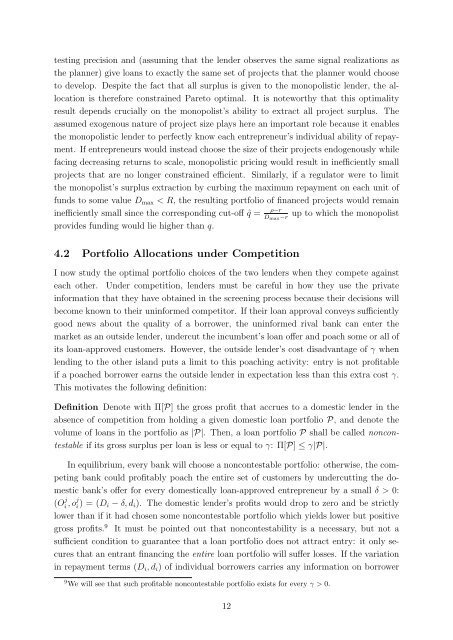Bank Competition, Information Choice and Inefficient Lending Booms
Bank Competition, Information Choice and Inefficient Lending Booms
Bank Competition, Information Choice and Inefficient Lending Booms
You also want an ePaper? Increase the reach of your titles
YUMPU automatically turns print PDFs into web optimized ePapers that Google loves.
testing precision <strong>and</strong> (assuming that the lender observes the same signal realizations as<br />
the planner) give loans to exactly the same set of projects that the planner would choose<br />
to develop. Despite the fact that all surplus is given to the monopolistic lender, the allocation<br />
is therefore constrained Pareto optimal. It is noteworthy that this optimality<br />
result depends crucially on the monopolist’s ability to extract all project surplus. The<br />
assumed exogenous nature of project size plays here an important role because it enables<br />
the monopolistic lender to perfectly know each entrepreneur’s individual ability of repayment.<br />
If entrepreneurs would instead choose the size of their projects endogenously while<br />
facing decreasing returns to scale, monopolistic pricing would result in inefficiently small<br />
projects that are no longer constrained efficient. Similarly, if a regulator were to limit<br />
the monopolist’s surplus extraction by curbing the maximum repayment on each unit of<br />
funds to some value D max < R, the resulting portfolio of financed projects would remain<br />
inefficiently small since the corresponding cut-off ˆq =<br />
provides funding would lie higher than q.<br />
ρ−r<br />
D max−r<br />
up to which the monopolist<br />
4.2 Portfolio Allocations under <strong>Competition</strong><br />
I now study the optimal portfolio choices of the two lenders when they compete against<br />
each other. Under competition, lenders must be careful in how they use the private<br />
information that they have obtained in the screening process because their decisions will<br />
become known to their uninformed competitor. If their loan approval conveys sufficiently<br />
good news about the quality of a borrower, the uninformed rival bank can enter the<br />
market as an outside lender, undercut the incumbent’s loan offer <strong>and</strong> poach some or all of<br />
its loan-approved customers. However, the outside lender’s cost disadvantage of γ when<br />
lending to the other isl<strong>and</strong> puts a limit to this poaching activity: entry is not profitable<br />
if a poached borrower earns the outside lender in expectation less than this extra cost γ.<br />
This motivates the following definition:<br />
Definition Denote with Π[P] the gross profit that accrues to a domestic lender in the<br />
absence of competition from holding a given domestic loan portfolio P, <strong>and</strong> denote the<br />
volume of loans in the portfolio as |P|. Then, a loan portfolio P shall be called noncontestable<br />
if its gross surplus per loan is less or equal to γ: Π[P] ≤ γ|P|.<br />
In equilibrium, every bank will choose a noncontestable portfolio: otherwise, the competing<br />
bank could profitably poach the entire set of customers by undercutting the domestic<br />
bank’s offer for every domestically loan-approved entrepreneur by a small δ > 0:<br />
(O j i , oj i ) = (D i − δ, d i ). The domestic lender’s profits would drop to zero <strong>and</strong> be strictly<br />
lower than if it had chosen some noncontestable portfolio which yields lower but positive<br />
gross profits. 9 It must be pointed out that noncontestability is a necessary, but not a<br />
sufficient condition to guarantee that a loan portfolio does not attract entry: it only secures<br />
that an entrant financing the entire loan portfolio will suffer losses. If the variation<br />
in repayment terms (D i , d i ) of individual borrowers carries any information on borrower<br />
9 We will see that such profitable noncontestable portfolio exists for every γ > 0.<br />
12
















